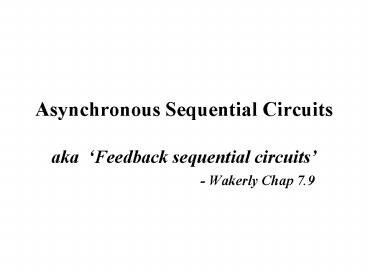Asynchronous Sequential Circuits aka - PowerPoint PPT Presentation
1 / 19
Title:
Asynchronous Sequential Circuits aka
Description:
Title: Introduction to VHDL Author: ep Last modified by: ep Created Date: 9/18/2000 6:42:36 PM Document presentation format: On-screen Show Company – PowerPoint PPT presentation
Number of Views:73
Avg rating:3.0/5.0
Title: Asynchronous Sequential Circuits aka
1
Asynchronous Sequential Circuitsaka Feedback
sequential circuits - Wakerly Chap 7.9
2
Asynchronous Circuits
- Not synchronous - Not clocked No flipflops
Inputs
Outputs
State variables
?t
- The circuit responds directly to changes in its
input signals - Circuit design must account for races and hazards
3
Uses for asynchronous design
- Flipflops (first case below)
- Situations in which synchronous design cannot be
used, either because - a clock does not exist, or
- it cannot be assumed that all devices are clocked
simultaneously - Asynchronous VLSI designs now used to reduce
power consumption, EMI
4
Analysis example
- To aid analysis and design, a simplifying
assumption is made that only one input changes
at a time fundamental mode - Consider -
5
Analysis example (2)
- From circuit
- We can now construct a table showing Y for all
values of inputs and Y (transition table)
Y 00 01 11 10 AB
0 1 1 0 0
1 1 1 1 0
Y Y
6
Analysis example (3)
- We now assign names to the state values and
distinguish between stable and unstable states
- A stable state exists when Y Y
Y 00 01 11 10 AB
S0 S1 S1 S0 S0
S1 S1 S1 S1 S0
Y Y
7
Analysis example (4)
- We can also derive output values, since -
Y 00 01 11 10 AB
S0 S1, 11 S1, 11 S0, 01 S0, 01
S1 S1, 11 S1, 10 S1, 10 S0, 01
Y, Q NQ Y, Q NQ
8
Asynchronous Design
- Primitive flow table
- PFT minimisation (State reduction)
- State assignment Race-free
- Excitation equations Hazard-free
- Output equations
9
Primitive flow table
- PFT is constructed to show the required state and
output for each input combination and transition - One stable state per row
- Remember fundamental-mode restriction
10
Primitive flow table (2)
A circuit has two inputs P and R, and an output Z
which is normally low. The output should be set
to 1 by a 0?1 transition on P and reset to 0
whenever R is 1 (Chap 7.10.2)
11
State reduction
- Equivalent states Same outputs, next
states(PFT will always include dont-cares due
to single-input change requirement) - Implication table may be used
- Reduced state table may then be Merged if there
are no conflicting states in any column
- 4 3 5 ? 1 4 3 5
1 4 3 - ? 1 4 3 5
12
State reduction (2)
- For current example IDLE, RES1 are combined to
give IDLEPLS1, PLS2 are combined to give PLS - Giving a reduced table -
13
Race-free state assignment
- In order to ensure that correct circuit operation
is not dependent upon specific gate delays, only
a single state variable must change for all state
transitions - Check by constructing an Adjacency diagram
It is not possible to give adjacent state
assignments in this example so an additional
state must be inserted
14
Race-free state assignment (2)
Additional state
Possible state assignment
15
Excitation and output equations
Must be hazard-free
16
Excitation and output equations (2)
- Finally check for essential hazards
17
Essential hazards
- A critical race between an input signal change
and a feedback signal change may cause an
incorrect state transition - Incorrect behaviour depends upon specific delays
in gates/interconnections - If from any stable state, the final state
reached after one change in an input is different
to that reached after three changes in that
input, then an essential hazard exists
18
Essential hazards (2)
Starting from PRY1Y2 1010 The final state can
be 00 or 01 for one or three changes in P But,
depending upon circuit delays, a single change in
P may cause an incorrect transition to state 01
- What circuit delays? We must ensure that input
signal delays are smaller than feedback signal
delays.
19
Essential hazards (3)
Buffer delay increased here































